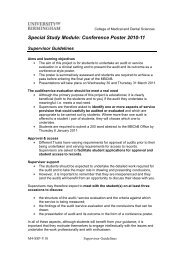Contents - College of Medical and Dental Sciences - University of ...
Contents - College of Medical and Dental Sciences - University of ...
Contents - College of Medical and Dental Sciences - University of ...
You also want an ePaper? Increase the reach of your titles
YUMPU automatically turns print PDFs into web optimized ePapers that Google loves.
The 11 th International Workshop on KSHV & Related Agents, Birmingham, UK<br />
Poster Session Abstract P5<br />
ENDOTHELIAL PROGENITORS FROM THE PERIPHERAL BLOOD OF PATIENTS<br />
WITH CLASSIC KAPOSI’S SARCOMA ARE PERSISTENTLY INFECTED BY KSHV<br />
Taddeo A 1 , Della Bella S, 1 Colombo E, 1 Brambilla L, 2 Bergamo E, 3 Calabrò ML. 3<br />
1Laboratory <strong>of</strong> Immunology, Dipartimento di Scienze e Tecnologie Biomediche, Università<br />
degli Studi di Milano; 2 Departiment di Dermatology, IRCCS Ospedale Maggiore,<br />
Milano; 3 Immunology <strong>and</strong> Diagnostic Molecular Oncology, Istituto Oncologico Veneto,<br />
IRCCS, Padova, Italy.<br />
Abstract<br />
Accumulating evidence indicates that tumor angiogenesis is supported by the<br />
mobilization <strong>and</strong> incorporation <strong>of</strong> endothelial progenitor cells (EPCs), highly proliferative<br />
precursors <strong>of</strong> bone marrow origin. Our recent demonstration that EPCs are increased in<br />
the peripheral blood <strong>of</strong> patients with Kaposi’s sarcoma (KS), together with the intrinsic<br />
biologic properties <strong>of</strong> these cells, strongly suggests that EPCs could be involved in the<br />
pathogenesis <strong>of</strong> KS. The fact that the characteristic spindle cells share many markers<br />
with vascular endothelial cells <strong>and</strong> are thought to be <strong>of</strong> endothelial origin further supports<br />
this hypothesis. A possible scenario may be that EPCs may act as preferential KSHV<br />
reservoirs <strong>and</strong>, whether infected, may home to permissive sites <strong>and</strong> propagate to<br />
produce KS lesions. Novel insights into the state <strong>of</strong> KSHV infection <strong>of</strong> EPCs could greatly<br />
improve the comprehension <strong>of</strong> KS pathogenesis. Therefore, we investigated KSHV<br />
infection <strong>of</strong> ex-vivo cultured late-EPCs that, among other cell populations with endothelial<br />
features, contribute more directly to neovascularization <strong>and</strong> might represent a major<br />
source <strong>of</strong> endothelial progenitors in vivo. We found that late-EPCs from KS patients<br />
harbor KSHV DNA <strong>and</strong> retain the virus after multiple passages. Lytic phase induction or<br />
hypoxia could amplify the virus in cells <strong>and</strong> supernatants, indicating that late-EPCs<br />
support KSHV productive replication. EPCs appear therefore to represent potential virus<br />
reservoirs <strong>and</strong> putative precursors <strong>of</strong> KS spindle cells. The biological mechanisms that<br />
govern the infection <strong>of</strong> EPC by KSHV are currently under investigation.<br />
Presenting author Email: lcalabro@unipd.it<br />
102















